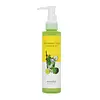What's inside
What's inside
 Key Ingredients
Key Ingredients

 Benefits
Benefits

 Concerns
Concerns

 Ingredients Side-by-side
Ingredients Side-by-side

Paraffinum Liquidum
EmollientCetyl Ethylhexanoate
EmollientPEG-20 Glyceryl Triisostearate
EmollientPEG-7 Glyceryl Cocoate
EmulsifyingIsopropyl Myristate
EmollientSorbitan Sesquioleate
EmulsifyingCitrofortunella Microcarpa Fruit Extract
AntioxidantCyclopentasiloxane
EmollientCyclohexasiloxane
EmollientCamellia Sinensis Seed Oil
HumectantOlea Europaea Fruit Oil
MaskingTocopheryl Acetate
AntioxidantVitis Vinifera Seed Oil
EmollientWater
Skin ConditioningButylene Glycol
HumectantMagnesium Ascorbyl Phosphate
AntioxidantChamomilla Recutita Extract
Skin ConditioningPrunus Serrulata Flower Extract
Skin ConditioningNymphaea Alba Flower Extract
Skin ConditioningPyridoxine Hcl
Skin Conditioning1,2-Hexanediol
Skin ConditioningRetinyl Palmitate
Skin ConditioningCentella Asiatica Extract
CleansingArachis Hypogaea Oil
Skin ConditioningPolygonum Cuspidatum Root Extract
AntioxidantScutellaria Baicalensis Root Extract
AstringentCamellia Sinensis Leaf Extract
AntimicrobialGlycyrrhiza Glabra Root Extract
BleachingRosmarinus Officinalis Leaf Extract
AntimicrobialChamomilla Recutita Flower Extract
MaskingTocopherol
AntioxidantParfum
MaskingParaffinum Liquidum, Cetyl Ethylhexanoate, PEG-20 Glyceryl Triisostearate, PEG-7 Glyceryl Cocoate, Isopropyl Myristate, Sorbitan Sesquioleate, Citrofortunella Microcarpa Fruit Extract, Cyclopentasiloxane, Cyclohexasiloxane, Camellia Sinensis Seed Oil, Olea Europaea Fruit Oil, Tocopheryl Acetate, Vitis Vinifera Seed Oil, Water, Butylene Glycol, Magnesium Ascorbyl Phosphate, Chamomilla Recutita Extract, Prunus Serrulata Flower Extract, Nymphaea Alba Flower Extract, Pyridoxine Hcl, 1,2-Hexanediol, Retinyl Palmitate, Centella Asiatica Extract, Arachis Hypogaea Oil, Polygonum Cuspidatum Root Extract, Scutellaria Baicalensis Root Extract, Camellia Sinensis Leaf Extract, Glycyrrhiza Glabra Root Extract, Rosmarinus Officinalis Leaf Extract, Chamomilla Recutita Flower Extract, Tocopherol, Parfum
Ingredients Explained
These ingredients are found in both products.
Ingredients higher up in an ingredient list are typically present in a larger amount.
Cetyl Ethylhexanoate is an emollient ester. It comes from cetearyl alcohol and 2-ethylhexanoic acid.
Cetyl Ethylhexanoate is an emollient that adds a velvety feel to skin without being greasy or oily. Emollients help trap moisture into your skin, keeping your skin soft and hydrated.
Isopropyl Myristate is an emollient, thickening agent, and texture enhancer. It is created from isopropyl alcohol and myristic acid.
It is used to help other ingredients be better absorbed. It is also an emollient and may help soften and hydrate the skin.
The comedogenic rating of this ingredient depends on the concentration. Lower amounts results in a lower rating.
Isopropyl Myristate may not be fungal acne safe. It can potentially worsen acne prone skin.
Learn more about Isopropyl MyristateParaffinum Liquidum is also known as liquid paraffin. It is a type of highly refined mineral oil.
Like other oils, Paraffinum Liquidum has emollient properties. Emollients help soothe and soften the skin. By creating a barrier to trap moisture within, emollients help keep your skin hydrated.
Paraffinum Liquidum does not irritate the skin and is non-comedogenic.
Learn more about Paraffinum LiquidumParfum is a catch-all term for an ingredient or more that is used to give a scent to products.
Also called "fragrance", this ingredient can be a blend of hundreds of chemicals or plant oils. This means every product with "fragrance" or "parfum" in the ingredients list is a different mixture.
For instance, Habanolide is a proprietary trade name for a specific aroma chemical. When used as a fragrance ingredient in cosmetics, most aroma chemicals fall under the broad labeling category of “FRAGRANCE” or “PARFUM” according to EU and US regulations.
The term 'parfum' or 'fragrance' is not regulated in many countries. In many cases, it is up to the brand to define this term.
For instance, many brands choose to label themselves as "fragrance-free" because they are not using synthetic fragrances. However, their products may still contain ingredients such as essential oils that are considered a fragrance by INCI standards.
One example is Calendula flower extract. Calendula is an essential oil that still imparts a scent or 'fragrance'.
Depending on the blend, the ingredients in the mixture can cause allergies and sensitivities on the skin. Some ingredients that are known EU allergens include linalool and citronellol.
Parfum can also be used to mask or cover an unpleasant scent.
The bottom line is: not all fragrances/parfum/ingredients are created equally. If you are worried about fragrances, we recommend taking a closer look at an ingredient. And of course, we always recommend speaking with a professional.
Learn more about ParfumWater. It's the most common cosmetic ingredient of all. You'll usually see it at the top of ingredient lists, meaning that it makes up the largest part of the product.
So why is it so popular? Water most often acts as a solvent - this means that it helps dissolve other ingredients into the formulation.
You'll also recognize water as that liquid we all need to stay alive. If you see this, drink a glass of water. Stay hydrated!
Learn more about Water